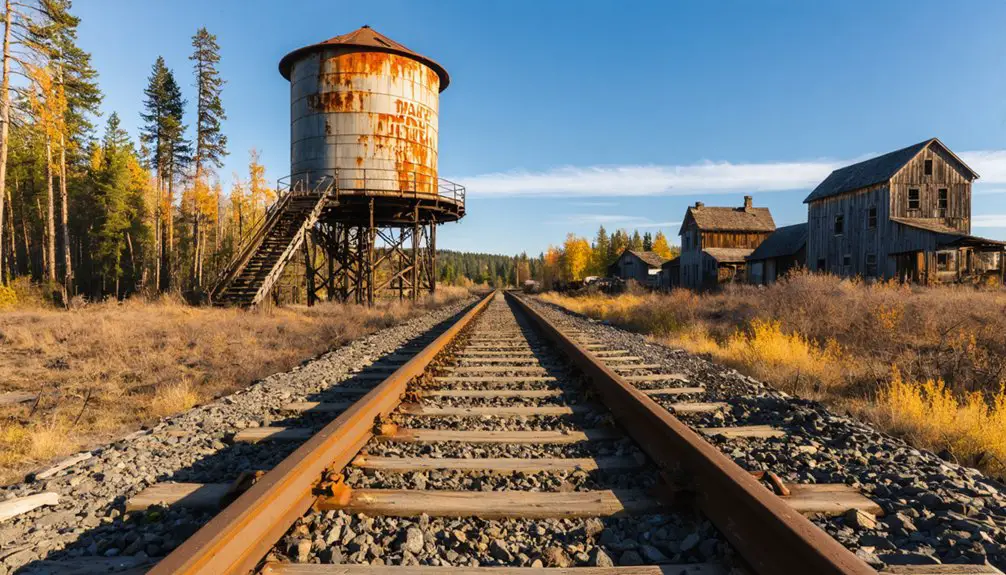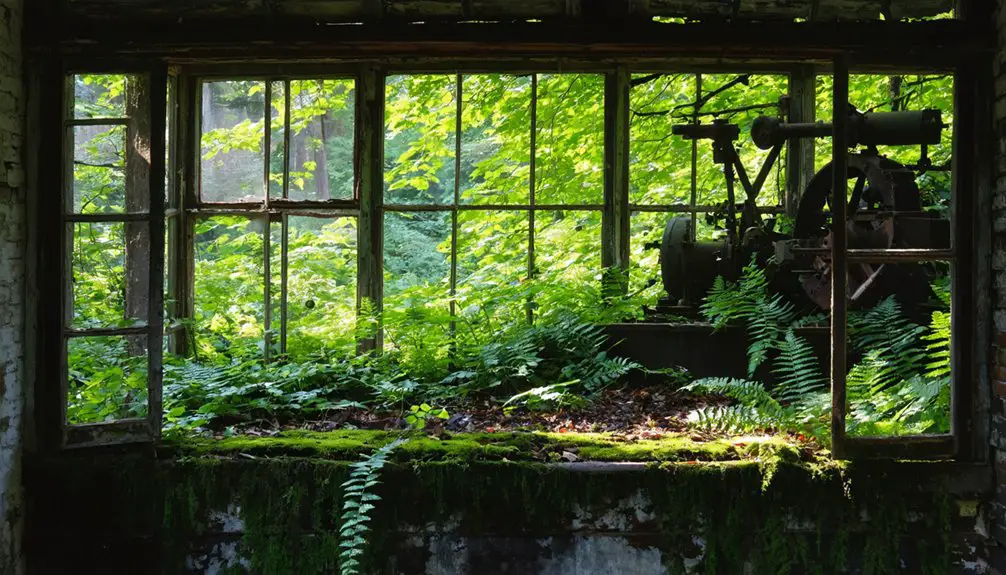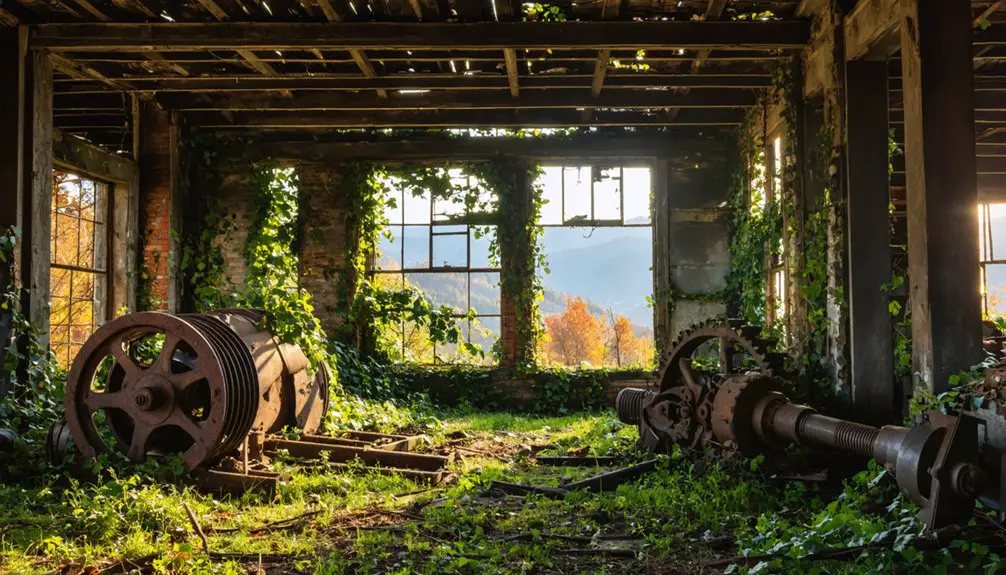You’ll find the remnants of Kinzua, Oregon hidden beneath a thick forest canopy. Founded in 1927 by E.D. Wetmore as a lumber company town, it flourished with 700 residents, a golf course, and a bustling mill that employed 330 workers. When the Eastern Oregon Logging Company closed in 1978, families dispersed, and nature swiftly reclaimed the land. Today, 400,000 Ponderosa Pines stand where this once-vibrant community carved out its legacy in timber country.
Key Takeaways
- Kinzua was a thriving Oregon company town founded in 1927, reaching 700 residents before becoming abandoned in 1978 following mill closure.
- The town’s economy centered around Kinzua Pine Mills Company, which employed 330 workers and owned 125 company-built homes.
- Residents enjoyed amenities like a six-hole golf course, movie theater, skating rink, and trout-stocked lake before abandonment.
- The Condon, Kinzua & Southern Railroad served the town, connecting its lumber operations to Union Pacific junction at Condon.
- Following abandonment, 400,000 Ponderosa Pine trees were planted in 1982, transforming the ghost town into forest-covered wilderness.
The Birth of a Company Town
When E.D. Wetmore founded Kinzua in 1927, you’d have witnessed the birth of a quintessential Oregon company town. Drawing inspiration from his Pennsylvania roots, he named the settlement after a Seneca word meaning “place of many fishes,” though his true focus was firmly on the timber industry.
The establishment of Kinzua Pine Mills Company in 1928 marked the beginning of complete company ownership over the community. Every building, from the newly established post office to the workers’ homes, belonged to the corporation. The company constructed 125 company homes to address the growing workforce needs. At its peak operations, the mill employed 330 workers who relied entirely on company-provided facilities.
You wouldn’t have found any private property here – it was all part of Wetmore’s vision for a controlled industrial hub. The town’s strategic location amid vast timber holdings made it an ideal base for harvesting the region’s abundant forest resources.
Daily Life in Kinzua’s Golden Years
If you’d visited Kinzua during its peak years around 1950, you’d have found a vibrant community where mill workers and their families enjoyed amenities like a six-hole golf course and a trout-stocked lake.
The company town’s 700 residents formed tight-knit social bonds through shared spaces including the library, tavern, and various gathering spots where they’d spend their leisure hours.
Despite the constraints of corporate oversight, families created lasting memories through community events and recreational activities, making the most of their remote timber town existence. The town’s primary employer, Kinzua Pine Mills, employed 330 workers during its most prosperous period. The town’s unique self-propelled railbus provided essential passenger and mail services, connecting residents to neighboring communities.
Community Activities and Recreation
During Kinzua’s heyday, residents enjoyed a rich array of recreational activities that belied the town’s remote location.
You’d find locals teeing off at the six-hole golf course or casting lines into the trout-stocked lake, making the most of community sports and outdoor adventures. The town’s social scene revolved around the tavern and restaurant, where you could swap stories after a day’s work. Entertainment flourished at the movie theater and rink, where families gathered for evening shows and skating.
Beyond organized activities, you’d discover endless opportunities for wilderness exploration in the surrounding forests. Like many Oregon towns facing economic fluctuations, the outdoor recreation helped maintain a strong sense of community spirit.
Whether you were hunting game, observing wildlife, or simply enjoying nature, Kinzua’s pristine setting offered year-round recreation. The railroad connection to Condon meant you weren’t isolated, allowing for weekend excursions and bringing visitors to enjoy the town’s amenities.
Mill Worker Family Life
Life in Kinzua revolved entirely around the lumber company’s influence, as you’d find in most company towns of the era. Mill worker traditions shaped family dynamics, with fathers and sons often starting their workdays before dawn.
You’d see generations of families following the same path – boys typically joined the mill right after school, just as their fathers had done.
The company’s support system made daily life easier for mill families. You wouldn’t need to travel far, with company-owned homes, stores, and a first-aid station all within walking distance.
The planned layout created a tight-knit community where work and home life seamlessly merged. At its peak in 1950, Kinzua’s population reached around 700 residents, making it a vibrant community. While this arrangement provided stability and convenience, it also meant your family’s entire livelihood depended on the mill’s success.
Social Bonds and Gatherings
Beyond the daily rhythm of mill work, Kinzua’s social fabric came alive through its impressive array of entertainment venues and gathering spots. You’d find yourself drawn to weekend dances, movie showings at the local theater, or friendly matches at the golf course.
The skating rink buzzed with youthful energy, while the tavern and restaurant hosted countless social interactions among neighbors.
Community events wove through every aspect of daily life. You might join a card party on weeknights, catch trout in the stocked lakes, or bump into friends at the well-stocked library.
The school served as a central hub where children formed lifelong friendships that often carried into their adult work lives at the mill. With a population of 700, you’d experience the perfect balance of small-town intimacy and vibrant social opportunities.
Economic Prosperity and Peak Population
As lumber operations expanded under E.D. Wetmore’s vision, Kinzua transformed from a modest timber camp into Wheeler County’s largest town.
You’d have witnessed remarkable timber prosperity as the Kinzua Pine Mills Company grew to employ 330 workers at its peak, supporting a population of 700 residents by 1950.
The mill’s success created a unique economic ecosystem where company loyalty defined daily life.
Kinzua’s economic heartbeat flowed through the mill, where company loyalty shaped every aspect of community life.
You’d find workers stepping straight from high school into well-paying mill jobs, while during World War Two, women joined the workforce in unprecedented numbers.
The town’s development mirrored the region’s shift from gold mining to timber as the primary economic driver after 1940.
The company owned everything – from the 125 homes where workers lived to the stores where they shopped.
This corporate structure provided stability but also meant residents’ fortunes were inextricably tied to the mill’s success.
The Railroad’s Vital Role

You’ll find that Kinzua’s economic heartbeat relied on the Condon, Kinzua & Southern Railroad, which served as the town’s lifeline from 1929 onwards.
The 24-mile rail line linked Kinzua’s bustling lumber mill to the Union Pacific junction at Condon, enabling the transport of raw timber and finished lumber products.
At its peak, the railroad ran up to five trains daily between the two points, ensuring the mill’s operations hummed with steady efficiency.
When Edward Wetmore established the railroad in 1927, it marked a transformative moment for the region’s lumber industry.
Lifeline To The Mill
The Condon, Kinzua and Southern (CK&S) railroad served as the beating heart of Kinzua’s lumber operations from its 1928 incorporation until its final days.
You couldn’t separate the success of Kinzua Pine Mills from this critical logging transportation link that connected the remote timber town to the outside world.
The railroad’s 24-mile lifeline to Condon meant everything to the local timber economy.
Five days a week, the CK&S hauled raw logs to the mill and shipped finished lumber out via the Union Pacific connection.
Without this rail service, the mill’s 330 workers couldn’t have maintained their productivity – there simply wasn’t another way to move such massive volumes of timber products efficiently.
The railroad didn’t just transport lumber; it carried the economic hopes of an entire company town.
Daily Train Operations
Running trains on the CK&S line demanded exceptional skill and patience from its crews, who faced some of Oregon’s most challenging railroad terrain.
You’d find them maneuvering steep 4% grades and sharp curves that limited speeds to a crawling 10 mph or less, especially in the mid-1970s as track conditions deteriorated.
Train schedules kept a steady rhythm, with five weekly runs between Kinzua and Condon during peak years, while Union Pacific made three weekly interchanges. Engineers had to exercise extreme caution after incidents of runaway cars in Bend had resulted in deaths.
The operational challenges were constant – engineers had to carefully manage heavy loads of timber and lumber on grades far exceeding typical 2% standards.
Despite these difficulties, the railroad maintained its crucial role until November 1976, when 58 federal safety violations and mounting maintenance costs finally brought operations to a halt.
The Final Days and Abandonment
Despite its once-thriving timber industry and close-knit community life, Kinzua’s final chapter began in 1978 when the Eastern Oregon Logging Company shuttered mill operations.
You would’ve witnessed a swift community decline as families packed up and moved away, seeking work in nearby towns like Fossil.
The company’s decision to consolidate operations in Heppner proved devastating.
Nature Reclaims the Land

While Kinzua’s human residents departed in 1978, nature quickly moved in to reclaim what was once a bustling timber town.
In a stunning display of nature’s resilience, the landscape transformed as 400,000 Ponderosa Pine trees were planted across 50,000 acres in 1982, effectively burying the old logging town beneath a new forest.
You’ll find few traces of human habitation today, as ecological restoration has erased most signs of civilization.
Here’s what happened:
Nature reclaimed Kinzua with silent determination, erasing human traces beneath new growth and welcoming wildlife back home.
- Native vegetation rapidly overtook roads and building foundations
- Wildlife like elk, deer, and woodpeckers returned in abundance
- The former industrial site merged seamlessly with surrounding wilderness
- Only the old golf course remains barely recognizable
The town’s physical legacy has virtually disappeared beneath thick forest canopy, while the land has returned to its natural state, teeming with life once again.
Frequently Asked Questions
Were Any Major Crimes or Notable Incidents Reported During Kinzua’s Existence?
In a million records, you won’t find any crime reports from this peaceful company town. No notable incidents occurred during operations, except planned expansions and the devastating post-closure arson in 1979.
What Happened to the Original Furniture and Equipment From Demolished Buildings?
You won’t find much trace of the original furniture and equipment – they were either relocated to Heppner’s mill operations, scrapped during demolition, or destroyed when buildings burned in 1979’s arson fire.
Did Any Famous People Ever Visit or Live in Kinzua?
Despite its rich timber history, you won’t find any celebrity sightings here. Historical visitors were mostly mill workers and their families, with E.D. Wetmore being the only notable figure connected to town.
What Was the Average Home Price and Rental Cost in Kinzua?
You wouldn’t find average prices since it was a company-owned town – workers rented homes for about $25 monthly in the rental market, with no private sales ever occurring.
Were There Any Native American Settlements in the Area Before Kinzua?
Over 5,000 years of Native American history exists in the John Day basin. You’ll find evidence of Warm Springs, Bannock, Northern Paiute, Cayuse, and Umatilla tribes who hunted and fished there.
References
- https://www.oregonencyclopedia.org/articles/kinzua/
- https://crookcountyhistorycenter.org/2022/07/kinzua-a-logging-company-owned-community/
- http://www.trainweb.org/highdesertrails/cks.html
- https://americanarchive.org/catalog/cpb-aacip_153-26m0ckkk
- https://www.opb.org/radio/programs/think-out-loud/article/kinzua-company-town-oregon-history/
- https://www.instagram.com/p/DFIGySnpjpy/
- https://sos.oregon.gov/archives/exhibits/ghost/Pages/logging-company.aspx
- https://dirtyfreehub.org/routes/oregon/kinzua/
- https://stage-sos.oregon.gov/archives/exhibits/ghost/Pages/logging-company.aspx
- https://npshistory.com/publications/joda/hrs/chap6.htm



